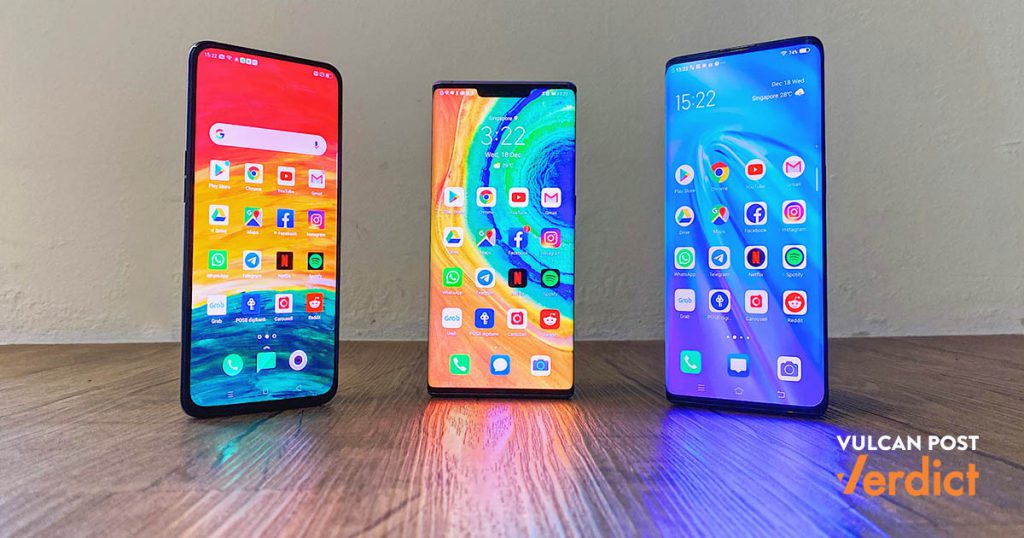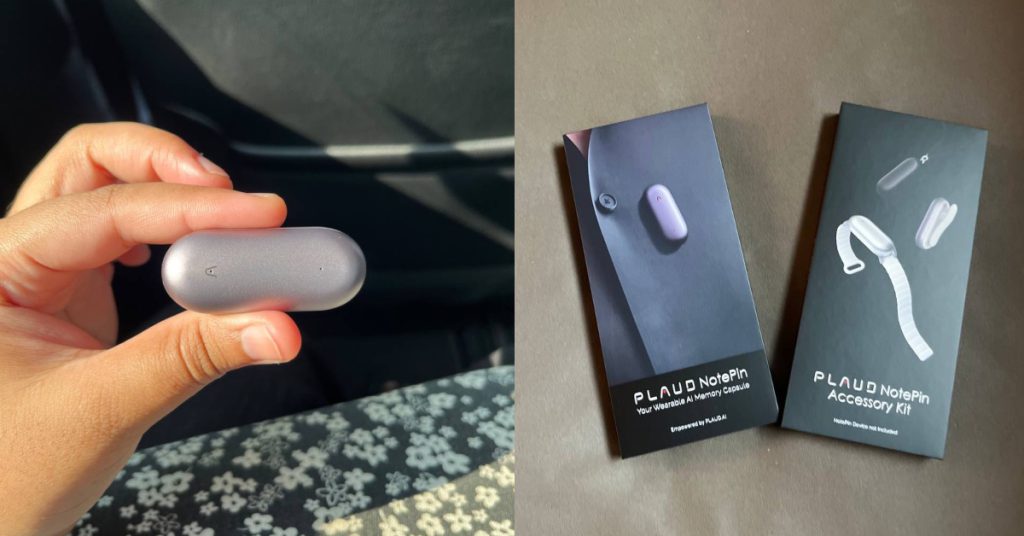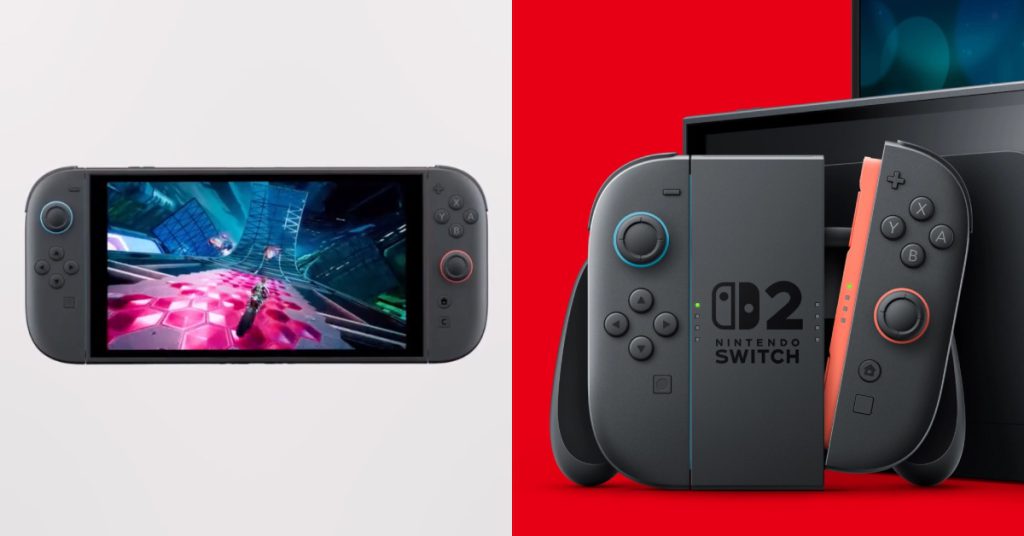When it was revealed that the Huawei Mate 30 Pro would not have access to Google Mobile Services (GMS) like Gmail, Google Maps and YouTube due to the US trade ban, there were concerns that the Chinese tech giant’s latest flagship would be a weak ending to their otherwise-stellar 2019.
Those concerns, however, appear to be for naught — people were finding workarounds to install the Google Play Store onto the phone almost immediately after its release, and the local launch in November drew a considerable queue of more than 200 people too.
But not everyone is willing to put in that kind of effort just to watch YouTube videos, and might be looking for an alternative to what should have been 2019’s best Android phone.
The recently-released Oppo Reno 2 and Vivo Nex 3 are two phones that offer similar features, so we’re pitting all three against other to see which is the right one for you.
Round 1: Aesthetics

We’ve reached a point where pretty much every phone looks the same, and the Mate 30, Reno 2 and Nex 3 are no exception. Upon closer inspection, however, you’ll notice that there are a few subtle differences that set the three apart from each other.
First up is the screen — both the Mate 30 Pro and Nex 3 feature “waterfall displays” that stretch past the front of the phone, while the Reno 2 rocks a more conventional setup. The waterfall display does make for a more bezel-less look (as far as the sides go, at least), but as far as we’re concerned the difference is negligible and we could have done with or without.
What we definitely could’ve done without, however, is the use of virtual volume buttons. In an attempt to streamline smartphone designs even further the Mate 30 and Nex 3 have ditched physical volume buttons, and in our tests the experience has simply not been up to par.
The Mate 30 Pro’s volume slider is activated by tapping the side of the phone, but even after a month it’s still a hit and miss to use. The Nex 3’s “buttons”, on the other hand, are situated in between the power button, and more often than not we found ourselves accidentally locking the phone when we wanted to adjust the volume.

And the problems don’t end there — unless you possess superhuman dexterity you can no longer adjust the volume without looking at your phone (we’re big fans of feeling for the buttons in our pockets/bags), and you can’t adjust it from a non-upright angle either (the Mate 30 is admittedly more guilty of this than the Nex 3).
To be fair, there are some saving graces — the Mate 30’s AMLOED display is the most vibrant of the three, while the Nex 3 has a 3.5mm headphone jack — a godsend for audiophiles who still prefer wired headphones over their wireless counterparts (then again, the Reno 2 also has one).
Unfortunately, these aren’t enough to make up for the bold, but ultimately flawed execution of such an integral part of the phone.
Winner: If it ain’t broke, don’t fix it — the Reno 2 takes the win here by ironically sticking to the basics.
Round 2: Performance

On the inside, the Mate 30, Nex 3 and Reno 2 are equipped with the Kirin 990, Snapdragon 855 Plus, and Snapdragon 730G processors respectively, with 8GB of RAM across all phones.
On paper the top-of-the-line Kirin 990 and Snapdragon 855 Plus should theoretically blow the mid-range Snapdragon 730G out of the water, but the truth is that chipsets have become so efficient that unless you‘re really scrutinising, you won’t notice that much of a difference in day-to-day performance between the three.
When it comes to the battery, both the Mate 30 and Nex 3 are equipped with above-average 4,500 mAh, while the Reno 2 has a smaller-but-still-respectable 4,000 mAh that doesn’t support wireless charging. A bummer, sure, but not a deal breaker.

All three phones will easily last a full day of use, but in our tests we found that the Mate 30 Pro had the longest battery life, with 30% still left at the end of the day (the Nex 3 and Reno 2 had 25% and 20% respectively).
All three phones also support fast charging, with the Mate 30 Pro once again having a very slight lead over the Nex 3 in reaching a full charge from 0%. It looks like as far as performance goes, the Mate 30 Pro is the one to beat.
Winner: This was probably the closest fight of all, but the Mate 30 Pro ultimately comes out on top.
Round 3: Camera

With most phones these days coming with the same basic features, the camera has become one of the more important aspects to look at.
Thanks to their longstanding partnership with Leica, it’s should be of little surprise that the Mate 30 Pro and its quad camera setup shines especially bright in this department. Even with its heavier focus on videography, photos have the level of vibrance and sharpness that we’ve come to expect from Huawei.



That’s not to say that Reno 2 and Nex 3 aren’t impressive as well, though. The Reno 2 also comes with a quad camera setup with comparable quality, and despite having one less camera the Nex 3 performs decently as well. You’ll be hard-pressed to pick a decisive winner, and it essentially boils down to a matter of personal taste.
All three phones also come with features that are slowly becoming the standard in phone photography, such as ultra-wide angle framing and night mode. The Mate 30 Pro, however, takes the lead thanks to its 30x digital zoom, compared to the Reno 2 and Nex 3 maxing out at 20x.

The Mate 30 Pro further extends said lead thanks to that aforementioned focus on video, offering unique features such as low-light videography super slow-mo that clocks in at an almost-unbelievable 7,680 frames per second.
Huawei established themselves as the camera experts with its P30 series earlier this year, and seem to be maintaining that lead with the Mate 30 Pro.
Winner: All three phones produce quality images, but the Mate 30 Pro once again comes out on top with its 30x zoom and superior video capabilities.
Round 4: Price
Specs aside, the biggest points of consideration when buying a phone is price. The Mate 30 Pro and Nex 3 retail at S$1,298 and S$1,299 respectively (way to undercut the competition, Huawei), which is par for course for a flagship Android smartphone.
The Reno 2, however, comes in at a rather surprising S$899. Considering that all three phones are more or less evenly matched, this makes Oppo’s offering a good choice for the more budget-conscious consumer.
Winner: At S$400 cheaper than the competition, The Reno 2 takes another win.
The Verdict

As you can probably tell by now, all three phones have their pros and cons — the Mate 30 Pro has the overall best specs and one of — if not the best — smartphone cameras on the market right now, but the uncertainty of losing GMS at any time might unfortunately be a deal breaker for some.
The Nex 3, on the other hand, offers Mate 30-esque specs and GMS, but doesn’t manage to reach the same levels as Huawei’s latest flagship. The phone is kind of just…there in the grand scheme of things, but if you consider GMS as a fair trade off then this might be worth considering.
Finally, the Reno 2 emerges the dark horse, offering comparable specs at the roughly two-thirds the price of its competition. Like the Nex 3 it doesn’t particularly stand out, but the significantly lower price tag makes it a little easier to swallow.
The bottom line is this: there isn’t one “perfect” phone, and your decision ultimately depends on what you consider important in one. Personally our choice at the end of all this still goes to the Mate 30 Pro, but whichever you choose to get, you can’t really go wrong.
VP Verdict is a series where we personally try and test out products, services, fads, and apps. Want to suggest something else for us to try? Leave a comment here or send the suggestion into our Facebook page.
Header Image Credit: Vulcan Post















